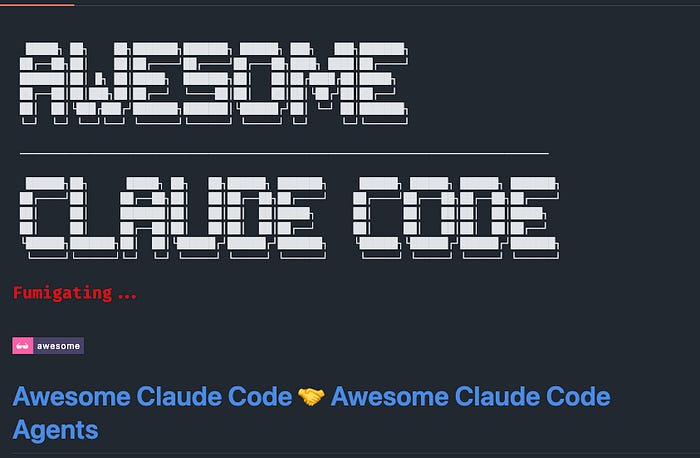I’m getting more and more obsessed with Claude Code. Sometimes I can barely sleep because I have FOMO if I’m not burning through tokens.
Honestly, I’m even happy when I hit the 5-hour time limit. At least it forces me to take a shower and eat.
In this article, I’ll share some of the tools and repositories I’ve been using over the past couple of days and that I find helpful.
CCStatusLine (Link)
Purposeccstatusline adds a beautiful, highly customizable status line to the Claude Code CLI. It shows important information such as token usage, context usage, time, cost, and other live metrics right in your terminal.
Why It’s Useful
It gives Claude Code users instant visibility into key session metrics without digging into logs or UI.
Managing context well is critical when working with Claude Code. If the context is too full, model outputs get worse.
👉 Pro tip: Use a double escape to jump back to a previous part of your conversation and delete irrelevant context.
Key Features
Real-time metrics: model name, git branch/changes, token usage (input/output/cached/total), context %, session clock, session cost, block timer, current working directory, and more.
How I set it up
First line: General info
Second line: Context management (watch
Ctx(u)— “Context usable”). This is the context before Claude Code automatically compresses. I usually try to keep it at ~70%.Third line: In, Out, Cached, Total Tokens
Claude Code also recently added the /context command, which gives a nice overview:
Awesome Claude Code (Link)
Purpose
A curated “awesome list” of commands, configs, hooks, tools, and guides to supercharge Claude Code. It helps you discover proven workflows, CLI/IDE add-ons, and best practices.
Why It’s Useful
Save time: skip hunting and copy ready-to-use commands, CLAUDE.md templates, hooks, and agent workflows.
Learn fast: see how others structure prompts, organize repos, and wire up automations.
Level up: borrow ideas, then adapt or build your own tooling.
Notes
There’s a lot in there. You won’t need everything, but skimming a few solid contributions will spark ideas, clarify what Claude Code can/can’t do for your setup, and point you to tooling you can adopt or fork.
How I use it
I check it every other day to see what’s new, bookmark standout items, and fold the best bits into my workflow.
BMAD-METHOD: Universal AI Agent Framework (Link)
Purpose
BMAD-METHOD is a full-stack agentic framework that brings structure and discipline to AI-assisted development. It combines agentic planning (Analyst, PM, Architect agents generating detailed PRDs and architecture docs) with context-engineered development (Scrum Master and Dev agents collaborating through hyper-detailed story files). Together, these two layers prevent the usual pitfalls of AI-driven coding: planning inconsistency and context loss.
Why it’s useful
End-to-end workflow: From PRD → architecture → story files → implementation, everything is covered.
Domain-agnostic: Expansion packs extend BMAD beyond software into creative writing, business, wellness, and more.
Validated practices: Story files give agents the “why” and “how,” not just the “what” — making outputs more reliable.
Tooling included: Comes with a codebase flattener tool that packages your project into AI-ready context for reviews, debugging, or architecture discussions.
Notes
It is honestly an impressive methodology for agentic coding. The workflow diagrams alone show how carefully thought out the system is. You won’t need every piece right away, but understanding the PRD + Architecture flow, and how agents collaborate through story files, can reshape how you think about building with AI.
How I plan to use it
I haven’t yet used BMAD on a production project, but I’ve heard repeatedly from others that it’s very effective. On my next project, I’ll try BMAD to see how well the planning → context → dev cycle translates to real-world software delivery. I’m especially curious about using the codebase flattener to feed full-project context into Claude Code.
Claude Code TypeScript Hooks (Link)
Purpose
Adds automatic code-quality hooks for Claude Code that run TypeScript, ESLint, and Prettier checks every time you edit files.
Supports React/Next/Vite apps, VS Code extensions, and Node.js TypeScript projects.
Why It’s Useful
Catches TypeScript and linting errors immediately during editing — before runtime or PR review.
Prevents regressions and saves review time by fixing/flagging issues at edit time.
Key Features
On-edit quality checks via Claude Code hooks (
PostToolUse) with silent success or clear error reports.Project-specific presets.
I added this hook recently, and it’s already helping the LLM avoid bad code (like as any).
It works by updating your settings.local.json like this:
"hooks": {
"PostToolUse": [
{
"matcher": "Write|Edit|MultiEdit",
"hooks": [
{
"type": "command",
"command": "node $CLAUDE_PROJECT_DIR/.claude/hooks/react-app/quality-check.js"
}
]
}
]
}Then, quality-check.js runs whenever Claude Code edits code.
⚠️ Note: Hooks execute often. The one above runs after each edit, so it’s important that it doesn’t bloat context or slow things down.
💡 Fun fact: According to Anthropic’s PM, the main reason they created hooks was to send themselves Slack notifications once Claude Code finishes running.
VibeTunnel (Link)
Purpose
VibeTunnel lets you run and view your Mac/Linux terminal sessions in any web browser. It proxies your local shells and commands to a browser dashboard so you can monitor and control them from your laptop, phone, or tablet.
Use the vt command to wrap any CLI (dev servers, tests, AI agents), stream output to the web UI, and manage sessions easily.
Why It’s Useful
Monitor long-running jobs and AI agents remotely without messy SSH setups.
Share and access your terminal from anywhere (mobile-friendly), with secure authentication.
I haven’t set this up yet, but I’m planning to. It looks like a great way to asynchronously get work done.
Funny side note: the founders of VibeTunnel are all Austrian (like me 🙃) — and apparently just as obsessed with Claude Code, maybe even unhealthily so.
An alternative would be Omnara (YC), but that’s more of a full platform. Personally, I’ll probably go with VibeTunnel.








